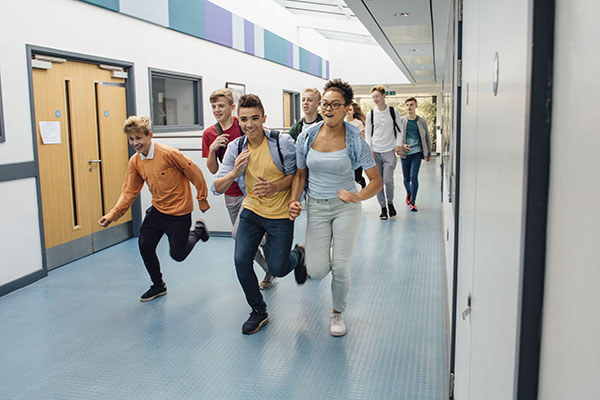
School-wide behavior programs can help promote a positive school climate
As mentioned in our “Why and how do we measure school climate?” post, a positive school climate improves student and staff well-being. For example, students learn best when a school establishes clear and consistent school-wide expectations for behavior. These types of school-wide approaches that target all students are referred to as Tier 1 supports of Positive Behavior Interventions and Supports (PBIS). Read more about PBIS and multi-tiered frameworks on our “Multi-tiered frameworks: Understanding RTI, PBIS, MTSS” post. Examples of Tier 1 supports can include establishing school-wide rules and increasing supervision in school common areas. The focus is on providing positive feedback when students are exhibiting appropriate behaviors and quickly correcting inappropriate behaviors. These approaches can help prevent negative incidents from occurring in the first place and promote a learning environment in which all students feel safe and engaged.
Foundations is a Tier 1 program that promotes positive discipline policies
Foundations is one example of a Tier 1 program that addresses school climate and safety by promoting positive discipline policies. The program was developed by Safe & Civil Schools and has been implemented in about 5,000 schools across 49 states. Implementing the program involves training sessions and program materials for members of the school’s leadership team, professional development for staff, and ongoing technical assistance over the course of about two years. Our SRI Student Behavior Research team has been actively involved in studying whether and how this program is effective in improving student and staff perceptions of school climate and safety, as well as student behavior and academic outcomes across two RCT studies.
Findings from our first study showed that students and staff attributed the Foundations program to improving school climate and student behavior
In the first study funded by the National Institute of Justice (NIJ), U.S. Department of Justice (DOJ), our team studied the impact of Foundations in secondary schools in the Pharr-San Juan-Alamo (PSJA) Independent School District, which primarily serves Hispanic and economically disadvantaged students. Eight treatment schools received training and technical assistance for two years to implement the Foundations program, while seven comparison schools did not (business-as-usual).
Schools in this study focused on implementing START on Time!, a Safe & Civil Schools curriculum designed to create safe hallway transitions and reduce tardiness schoolwide.
The guidelines for this curriculum included that students walk on the right-hand side of the hallway to improve student behavior in hallways, promote safe transitions in between classes, and encourage an overall positive school climate. In addition, teachers should be visible in the hallways during passing periods to encourage students to get to class on time, praise students for good behavior, and greet students as they enter their classroom. Students even helped reinforce these guidelines by making their own school safety videos:
One advisor noted that teacher buy-in increased “when they [saw] how it was working and [saw] the students responding.” For example, in one interview, a teacher said she overheard a student say at the end of the first year of the initiative, “I gotta go because I don’t want to get swept,” meaning that a staff member was conducting a “sweep” to gather tardy students into a room in order to complete tardiness records before returning students to class. Further, the student school climate survey results showed that students at the treatment schools reported being less likely to have been bullied in the past 30 days than students in the comparison schools.
Our second study of the Foundations program in middle schools across California, Oklahoma, and New York is currently underway
We are also currently in year 2 of another RCT study that is funded by the Institute of Education Sciences (IES), U.S. Department of Education (DOE). This study examines whether implementing Foundations leads to improvements in school-wide behavioral and academic outcomes. We are continuing to collect and analyze our data from 42 participating middle schools across California, Oklahoma, and New York.
Taking steps to improve school climate is an important way to promote positive outcomes and ensure that students and staff are feeling engaged and safe at school. To learn more about these projects and how the Foundations program impacts school climate, check out these resources:
- Efficacy Study of Foundations, School-wide Positive Discipline for Middle Schools
- Foundations – Schoolwide Positive Behavior Support (PBS)
The information reported here was supported by the National Institute of Justice through Grant #2014-CK-BX-0015 to Phar-San Juan-Alamo Independent School District and SRI International. The opinions expressed are those of the authors and do not represent views of the National Institute of Justice.
The information presented here is supported by the Institute of Education Sciences, U.S. Department of Education, through Grant R305A160005 to SRI International. The opinions expressed are those of the authors and do not represent views of the Institute or the U.S. Department of Education.
Topics: School climate School-wide prevention
Tags: Foundations Positive Behavioral Interventions and Supports Randomized Control Trial Tier 1
